| - Table of Contents & Quick Links - |
SUNSPOTS
- Cooler dark spots on the surface of the Sun. These are areas of intense magnetic activity grouped together in clusters. The average number of spots in each cluster is about 10 spots. Some groups will have a positive polarity and some will have a negative polarity. Together they function like huge magnets. They can last for hours or months at at time. Sunspots mark periods of increased magnetic activity within the Sun and are the generators of Solar Activity.
- A pharmacist & amateur German astronomer, Heinrich Schwabe; was looking for the planet Vulcan (inside the orbit of Mercury). What he discovered instead (after 10 years of looking) was the Sunspot Cycle.
↓
|
SOLAR PROMINENCES
Loops extending from the Sun's Photosphere to its Corona
SOLAR FLARES
Large Explosions in the Sun's Atmosphere
↓
|
CORONAL MASS EJECTIONS
(CME'S)
- Large loops of gas & magnetic fields thrown off by the Sun at high speeds. They are related or connected to Solar Tsunamis which are giant waves that move through the dense laters of the Sun. Coronal Mass Ejections and Solar Tsunamis occur when there has been an explosion on the Sun.
- Should a CME cross paths with the Earth, the planet would be in contact with the CME for a period of 2 hours ... the length of time the CME would take to pass the Earth. The equivalent of 01º of Longitude in terms of direct contact.
↓
|
 |
| Click To Enlarge: Spotted Sun & Spotless Sun |
|
|
 |
| Click To Enlarge: Solar Prominence |
|
|
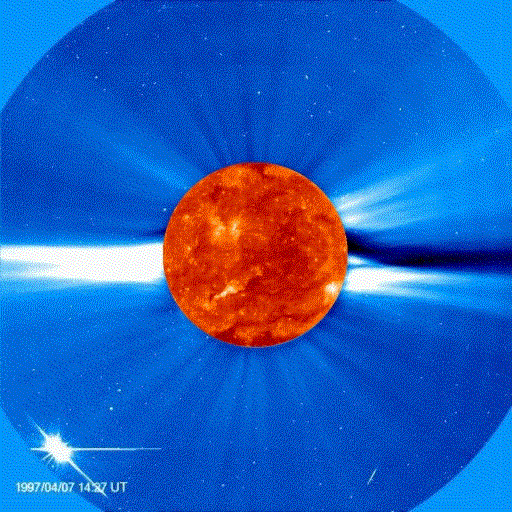 |
| Click To Enlarge: 1997 CME |
|
|
 |
| Click Image to Enlarge: Sunspot |
|
|
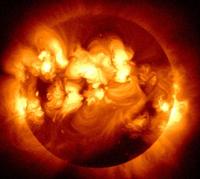 |
| Click To Enlarge: Solar Flares |
|
|
 |
| Click Image to Enlarge: Mass Ejection |
|
|
How Can
CME's
Make the Power Go Out?
|
|
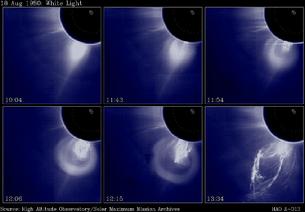 |
| Click Image to Enlarge: CME photo taken by Solar Maximum Mission Spacecraft & provided by NCAR |
|
|
 |
| Click To Enlarge: Solar Cycle #24 (as of Nov. 2009) |
|
|
 |
| Click Image To Enlarge: 400 year spread of SunSpots with Maunder Minimum & Dalton Minimum + Modern Maximums |
|
|
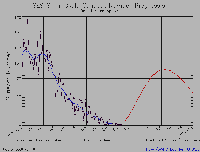 |
| Click Image to Enlarge: sunspot progression thru April 2009 |
|
|
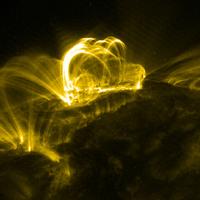 |
| Click to Enlarge: SunSpots in Action |
|
|
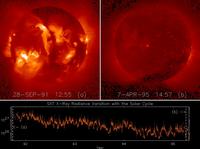 |
| Click Image to Enlarge: Comparison of High Sunspot activity in 1991 with Low Sunspot activity in 1995 & difference in "Solar Radiance" |
|
|
 |
| Click Image to Enlarge: SunSpot Progression Thru Sept 2009 |
|
|
|
|
 |
| Sunspot 1084 taken on 02 July 2010: Its just a bit bigger than the Planet Earth. [“This photo of a sunspot is now the most detailed ever obtained in visible light,” according to Ciel et l’Espace.] (click to enlarge) |
|
|
**** FIRST SOLAR RADIATION STORM OF SOLAR CYCLE 24 ****
-
 On Saturday, August 14, 2010 a small solar flare erupted on the Sun at about 6am EDT. Associated with this flare was a coronal mass ejection (CME) that was partially directed towards the Earth. On Saturday, August 14, 2010 a small solar flare erupted on the Sun at about 6am EDT. Associated with this flare was a coronal mass ejection (CME) that was partially directed towards the Earth.
Also associated with this event was a S1 or minor solar radiation storm. The only impacts expected for a solar radiation storm of this magnitude are minor impacts to HF radio communications in the polar regions.
However, this is the first solar radiation storm of Solar Cycle 24 and the first solar radiation storm since December of 2006.
|
|
- Geomagnetic Storms: disturbances in the geomagnetic field caused by gusts in the solar wind that blows by Earth - [G1-G2-G3-G4-G5]
- Solar Radiation Storms: elevated levels of radiation that occur when the numbers of energetic particles increase - [S1-S2-S3-S4-S5]
- Radio Blackouts: disturbances of the ionosphere caused by X-ray emissions from the Sun - [R1-R2-R3-R4-R5]
- The K indexes and G indexes give an idea of the degree and type of the magnetic energies hitting the earth.
|
|
THE EARTH HAS DEVELOPED SOME LEAKS
- There are now 2 large gaps or holes in the Earth's magnetosphere (as of May 2009 & originating in June of 2007). The magnetosphere is what protects the Earth from all the those Solar Storms. It usually works like this:
- Solar Wind protects the Earth from Cosmic Radiation. It travels at about One Million Miles Per Hour and keeps about 90% of the radiation from other Stellar bodies away from the Earth. This Solar Wind creates what is known as The Heliosphere. This Solar Wind wraps the Earth in a sort of wind tunnel that keeps out the bad things from space trying to reach the Earth. The Solar Wind hits a sort of boundary in the space just ahead of and around the Earth and forms a sort of wall that protects the Earth.
- The Sun's Heliosphere is also shrinking and has weakened by 25% over just the last 10 years.
- The Earth's Magnetosphere protects the Earth from Solar Storms
- The Sun's magnetic poles shift reverse their polarity on a regular basis.
- When the Sun's Magnetic Poles happen to line up with the Earth's Magnetic Poles, the Earth's Shield develops leaks with 20 times more Solar energy hits the Earth. This band of extra solar particles is already the width of the planet earth itself and ... it is growing.
- Not only that, but; great globs of plasma are attaching themselves to the Earth's magnetic field and sort of helping to "hold open the gates", or: keeping the earth's shields "down".
- LINED UP SUN-EARTH MAGNETIC FIELDS = MORE RADIATION GETTING THRU TO THE EARTH'S ATMOSPHERE AND "US"
- NON-LINED UP SUN-EARTH MAGNETIC FIELDS = LESS RADIATION GETS THRU TO THE EARTH'S ATMOSPHERE AND "US"
READ MORE ABOUT THE CURRENT STATE OF THE SUN-EARTH MAGNETIC FIELDS BELOW↓
'THEMIS & THE BREACH"
| THE ORDER MATTERS
- The Sun Reverses or "flips" its magnetic pole during every 11 year sunspot cycle. On or about Feb. 15th 2001, the Sun flipped its magnetic field, The north magnetic pole is now pointing south. The Flip occurs at a Solar Maximum (the peak of a sunspot cycle) when the magnetic poles exchange places. Its next "flip" is expected around 2013.
- The Sun contains "jet streams" that travel 7000 km below its surface. Every 11 years, the Sun gives birth to a new set of jet streams near its poles. These "jet streams' move toward the equator and when they reach the point of 22º latitude .... Sunspots begin to appear.
- A NON ALIGNMENT of the Sun-Earth magnetic fields doesn't allow too much Solar Energy to penetrate the Earth's atmosphere. So even with an active Solar cycle; with an Active Non-Aligned Sun ... not much occurs. The Earth's magnetosphere is solid and keeps volatile radiation out.
- Then, even if a "Solar Pole Flip" occurs at the End of a Non-Aligned 11 year Solar cycle and Flips to Aligned (starts letting in a lot of radiation) ... even with an active Sun full of Sunspots, Flares, & CME's now able to get its energy through the Earth's atmosphere (it can act like a match on lighter fluid soaked charcoal), it won't have much to work with or "ignite" in the Earth's atmosphere. The Earth would have been able to keep most of it out.
- But; If most of the Sun's 11 year cycle is spent in An ALIGNMENT Cycle of the Sun-Earth Magnetic Fields ... then tons of radiation gets through and begins building up in the Earth's atmosphere.
- Even with the Sun in a quiet period which also lessens the Solar Wind, more Cosmic Radiation ends up getting thru to Earth's atmosphere. So now, the Earth's got more Solar Particles getting in due to Sun-Earth Magnetic Alignment... AND more Cosmic Radiation as well. Its as if lots of lighter fluid starts soaking into charcoal... and the Earth's atmosphere is the charcoal!
- Scientists worry that if the Sun goes ACTIVE with a lots of Spot, Flares, & CME's and the Earth is "wide open" or; if the Sun releases a really big CME in the Earth's direction while its atmosphere is so full of volatile radiation; then either the CME (whether there is alignment or nonalignment) or an Active Sun with Alignment .... could trigger all that built up radiation and send the Earth ... or parts of it, a lot of grief.
|
|
- 2013 UPDATE: As of December - The Sun currently has 2 South Poles ... the South Pole has yet to "flip" to become the new North Pole ... meanwhile; the North Pole has already flipped to become the new South Pole.
|
"THEMIS"
NASA had 5 THEMIS probes which launched in February 2007 as "The THEMIS Mission.
Then; on June 3rd, 2007 ... A HUGE HOLE began to open up ...
AND just as this hole was opening up ...
the THEMIS probes flew right through the hole itself;
a hole ( or gate) 4 times wider than the Earth itself.
- This gate then lets the Solar wind pour into the Earth's
magnetosphere at the rate of 1027 particles per second. And if a big enough CME should hit the this accumulation of plasma? CME's in even number Solar Cycles tend to hit the Earth with a leading edge that is magnetized north. Solar Cycle 24 has just begun. We may be in for huge geomagnetic storms at the height of this cycle.
- HOW can this happen? Our Sun (acting like a giant octopus) sends out long tentacles made up of magnetic fields. When those tentacles are the same magnetically as the Earth's own fields ... The Earth's magnetic fields above its North & South Poles can "hook up" with the Sun's magnetic fields and form "roadways" over the Arctic & the Antarctic which WITHIN MINUTES can expand all the way to the Earth's Equator where they then overlap each other. This happened in June of 2007.
- The entire "Dayside" of the Earth becomes wide open to whatever is getting through this "Solar Gate". Usually, the Earth's magnetosphere opens to the Solar Wind emanating from the Sun's Southern Magnetic field. This time, in June of 2007, it opened to the Solar Magnetic Field that was pointing "North". (This is tatamount to saying the Sun just rose in the West instead the East)
- Usually, the Solar wind hits the Earth above the Earth's Equator. But this time when the North pointing Solar Wind hit the Earth's North Magnetic Pole instead of pushing each other away ... they "joined" forces and allowed the Sun to pour enourmous amounts of Plasma into the Earth's Magnetosphere.
- The Sun's North Magnetic Winds hit the Earth's North Magnetic fields and formed a "Gate".
|
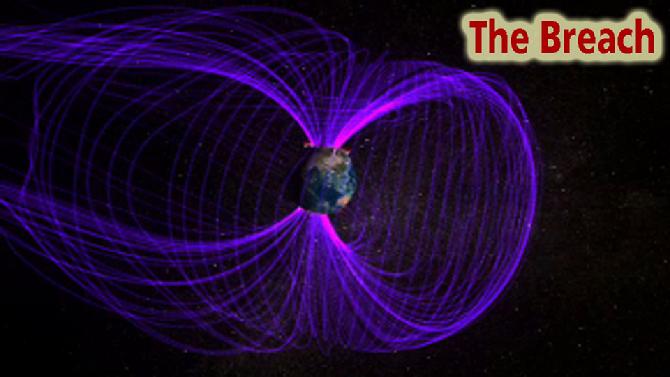 |
| Click Image To Enlarge |
|
|
- While non-aligned magnetic interaction between the Earth & the Sun allows for small holes to enter the Magnetosphere (we can see the Solar Wind reflected in the Aurora Borealis);
- Alignment allows for a literal "gateway" to open that "funnels" the Solar Winds into the Earth's Magnetosphere.
The Difference in these 2 scenarios is illustrated by NASA →
|
 |
| Click Image To Enlarge |
|
|
| Solar Flare Anomaly: 5 December 2006: According to Jaysen Rand .... This Solar Cycle #23 Anomaly never really happened at all . |
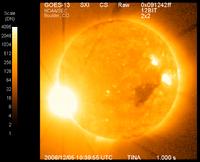 |
| Click To Enlarge: 05 Dec 2006: Solar Flare Anomaly |
|
|
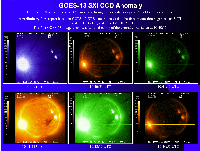 |
| Click Image To Enlarge |
|
|
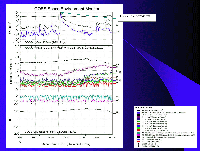 |
| Click Image To Enlarge |
|
|
NOTE: The Sun had been acting a bit "strangely"
If the Sun flips its polarity when it reaches the height of a Solar Maximum ( sunspot cycle) and it did so on Feb. 15, 2001; then why all this rather huge activity when it shouldn't be approaching another maximum until (at the time it was thought to be 2012) 2013-2014?
The Sun was "spotless" on October 6th, 2009.
Solar Cycle #24 has officially begun; but very, very, quietly.
|
| EARTH & SUN: THE BASIC SET-UP |
 |
| The Earth's Protective Gear: Click Image to Enlarge |
|
|
 |
| Solar Flare Heads For Earth: Click Image To Enlarge |
|
|
 |
| The Earth Reacts: Click Image to Enlarge |
|
|
 |
| Click Image To Enlarge: Sun's particles' "gathering spot" in front of the Earth's magnetosphere (ENA = Energetic Neutral Atoms) |
|
|
 |
| Click Image To Enlarge: The Sun's Emissions (metals is in black at the top) |
|
|
 |
| Click Image To Enlarge: Earth's MagnetoSphere |
|
|
 |
| Click Image To Enlarge |
|
|
- The Solar Wind ( protons, electrons) flows over the Earth's atmosphere of ionized gases.
- This in turn produces "Plasma" within the Earth's Magnetosphere.
- Plasma is a superhot ionized gas.
- Plasma is referred to as the 4th state of matter.
- Within Plasma, the electrons are no longer anchored or "stuck" to the nucleus of a atom. Instead, they roam around freely.
- Plasma is "matter" superheated to Matter's "4th State".
|
 |
| Click Image to Enlarge: Plasma Atoms (electrons in yellow) |
|
|
| MORE ABOUT THE SUN ... The Present Projections as of 2011 |
- The Maya (300 AD - 900 AD) referred to an active Solar Sunspot cycle as: "The Jaguar Sun" (a jaguar has lots of spots).
- 1610 - Galileo made observations of Sunspots back in 1610.
- 1749 - The Zurich Observatory began observations in 1749.
- 1849 - Constant or continuing "modern day" observations began in 1849.
- 1874 - The Royal Greenwich Observatory has kept detailed observations since 1874.
- These Sunspots are generally concentrated in 2 latitude bands on either side of the Sun's Equator (like our Tropics of Cancer & Capricorn). They form a sort of Wedge pattern that narrows toward the equator. Scientists refer to this pattern as a "butterfly".
- It's not the sunspots themselves that affects things; but the intense magnetic activity that comes along for the ride. This magnetic activity causes changes in the amount of Ultraviolet Rays and X-Rays which hit Earth's upper atmosphere. More sunspots, more magnetic activity.
- The Sun's own magnetic field usually shifts around; sometimes it lines up with Earth, other times not.
- When the Sun's magnetic field is aligned opposite to the Earth's, less solar particles enter Earth's atmosphere. So, the Earth's magnetosphere is strongest when the Sun points its magnetic field "somehwere else".
- BUT: when the Sun's magnetic field is lined up with the Earth's North & South Magnetic Poles; then the Earth develops "holes" and about 20 times as much Solar particles or energy hits the Earth.
|
SQUARE ONE: THE SUN = THE WEATHER
- When the Sun is Inactive (few sunspots): It gets colder on Earth
- When the Sun gets Active (many sunspots): It gets hotter on Earth
-
The Sun was in an Inactive phase during from 1645 to 1715. As such, this period of time is also referred to as: "The Little Ice Age".
- Sunspots equate to the amount of energy the earth gets from the Sun. Generally the Sun's spots operate on an 11 year cycle. 11 Active and 11 quiet ... supposedly ... one right after the other.
- NOTE: The sun produces: SPOTS, FLARES, & CME's (Coronal Mass Ejections)
- When the Sun's Poles are NOT aligned with the Earth's; LESS Solar particles get thru to the Earth and those that do hit the equator area of the earth.
- When the Sun's Poles ARE aligned with the Earth's and MORE Solar Particles are coming in; those particles hit at the Northern Latitudes on the Earth.
NOTE:
- The Sun has just finished an active Sunspot Cycle and is still in a Quiet or Inactive Sunspot Cycle. In fact, the Sun has been more quiet for longer than expected.
Scientists are now projecting the next Active Solar Cycle to begin in May of 2013.
- BUT: Solar Cycle #24 has begun. When the Sun's Jet Streams reach the Solar Latitude of 22º; well ... sunspots ought to start appearing again. Currently, scientists are expecting a very active period (possibly starting up towards the end of 2011)
|
|